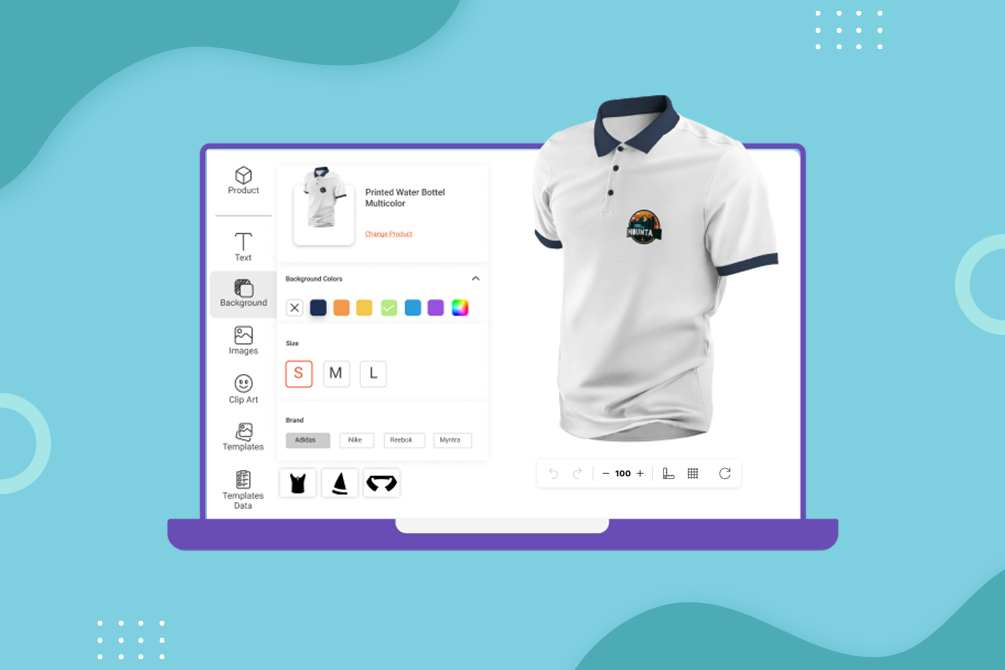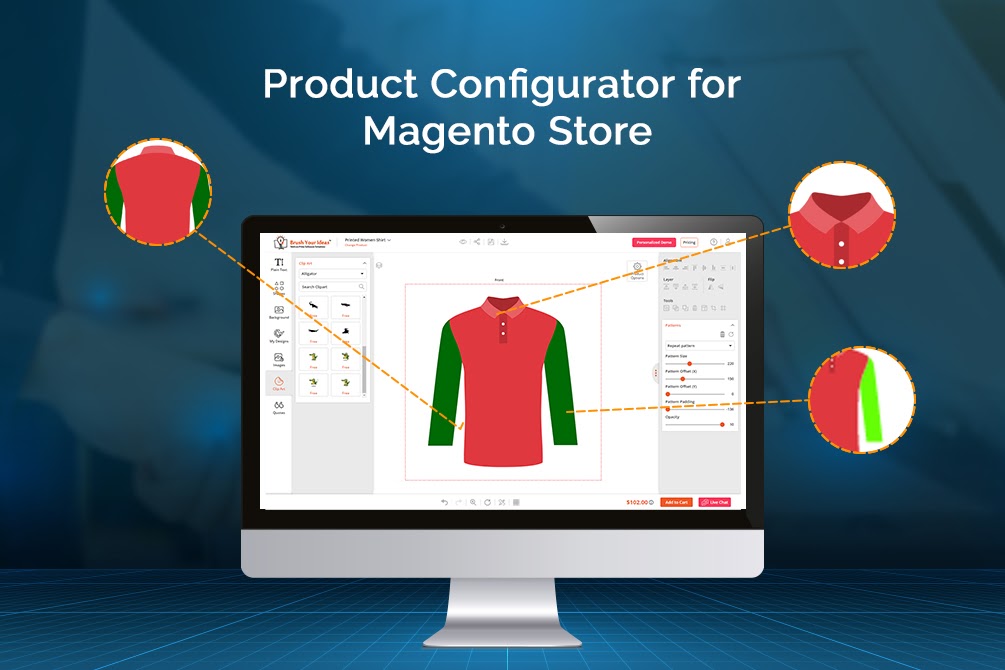Summary
Have you ever purchased something online that didn’t live up to the photographs on its product catalog? The exact terminology for this is called buyer’s remorse. It is something that everyone as a consumer wants to avoid. This buyer’s remorse certainly contributes to the fact that buyers in America end up buying only 58% of the items present in their online shopping carts each year.
If you are a brand and your buyers face the same issue with your product, you are certainly in trouble. A customer may never return to your store if they’re unsure about the look and feel of the products you sell. How do you make them click the “order” button in such a scenario? Customers need to feel confident about whatever they order. They should feel confident about the fact that their order will match the shipment they receive.
You can easily maintain the look and feel of non-customizable products. But, for products with customization, it gets a little trickier. Hence the concept of ecommerce product configurator came into existence. A visual product configurator is a powerful selling tool, essentially for customizable products. Here’s an exhaustive guide to understanding the know-how of Product Configurator where we’ll talk about:
What is an Ecommerce Product Configurator?
A product configurator is a design tool that allows users to customize the products of their choice based on available configuration options. An ecommerce product configurator is an interactive and engaging tool. Most businesses offer configurations in color, print, text, images, textures, and more.
For example, if you’re selling a T-shirt online, you can display a visual configuration. Shoppers could try out the designs and see what it would look like if they swapped different components such as, size, design, color, etc. In a few simple clicks, they’ll know exactly what their customized product will look like before they purchase it.
Product Configurators: Need Vs. Capabilities
Due to the growing popularity of product personalization, many companies have started offering product configurations. The key necessities of these configurators can’t be realized until brainstormed completely. Still, they cover a whole set of applications with different objectives and target audiences.
The common purpose of configurators is the personalization of consumer goods. But, product personalization of consumer goods is only the visible part of a much bigger iceberg. Configurators are capable of serving various other stakeholders of a product too. Designers, engineers, operators, sales representatives and so on are on constant lookout for a navigation tool that centralizes the product options and constraints.
A product configurator is a powerful tool for communication with stakeholders with certain expertise. It is an ideal platform to implement a mass customization strategy. Hence it is necessary to have a crucial understanding of the type and complexity of the product first. The conception and implementation phase of the configurator comes way after the basic product understanding.
See how you can take your business to the next level with configurators. Understand how it works here.
Why use Product Configurator?
A study states that 57% of consumers will stop buying from a company, if a competitor provides them a better experience. In another study, 82% customers believe that ecommerce companies have a responsibility to reduce returns. In fact, 76% say they would return items less often if online retailers provide them with more accurate and clear images and product descriptions.
Hence creating a positive customer experience is vital to the long-term success of companies. This means reducing friction, acknowledging the challenges, and delivering exactly what the customers expect.
Following are a few ways that product configurators benefit ecommerce companies, and why everyone must consider the product configurator option:
- It leads to an increased digital footprint on your ecommerce stores and improves engagement
- The customers who visit your store are more likely to make a purchase hence resulting in higher conversion rates
- Customers are less likely to return products if they can clearly see, and visualize the offerings. Hence, lesser return rates
- Customers can render images of every component and not just the assembled product.
- It provides design flexibility and scalability.
- Products displayed using Augmented Reality are more likely to attract a large number of millennials as well as Gen-Zs.
Let’s have a look at different types of product configurators.
Types of Product Configurator
Before we move on to product configurators here’s a quick brief about the three types of configurations possible.
- Personalization Personalization refers to the process of adding text, number, message etc. to an already designed product. Personalization gives a unique identity to consumers.
- Customization Customization allows users to create a new design from a template using various designing features such as colors, text, prints, images, logos, and so on.
- Parametric Configuration Parametric configuration means the users can change any design parameter flexibly. They can change design parameters such as product width, height and so on.
Product configurators are of various types based on dimensions, industry, target audience and so on. Here’s a detailed overview of these classifications:
Ecommerce Product Configurator Based on Dimensions
There are two types of visual product configurators based on dimensions that can help your customers get a better sense of their purchase: Static 2D and Interactive 3D.
- Static 2D 2D product configurators generally present a flat image that does not move. Shoppers are not able to spin the product around and cannot have a 360 view of it. Customers can only have a look at the 2D photos from every angle if the seller has uploaded them. The only purpose of this configurator is to let the customer change the components such as colors, materials, add-ons.
- Interactive 3D 3D configurators are responsive and interactive as compared to the 2D ones. Buyers can rotate the products and get a 360-degree view of it. Along with this, they can change the customizable features just like a 2D configurator. Interactive 3D configurators are the best way to make sure that shoppers know exactly what they’re purchasing.
Ecommerce Product Configurator Based on Industry
Configurators are useful for both B2B and B2C businesses.
- B2B Configurators Primarily, sales representatives use configurators during the CPQ (Configure, Price, Quote) process. It provides the sales reps to provide quick and accurate quotes to clients. Some benefits of B2B configurators are:
- Reduces the sales cycle time
- Minimizing human errors
- Provides an engaging experience
- Up-to-date product information
Example: Herman Miller
Herman Miller is one of the most popular names in office and home furnishings. It is one of the top B2B sellers of premium furniture. They provide their customers with a way to preview their customizable office chairs before purchasing.
.gif?width=1104&name=Large%20GIF%20(1104x774).gif)
- B2C Configurators The use of the configurator for B2C is quite clear in the customization industry. It provides an easy avenue for end-customers to co-design their products, giving them a sense of ownership.Example: There can be various examples of companies that provide product configurators. Most companies now provide at least the 2D configurator option. Here’s a configurable watch with various components and a combination logic.
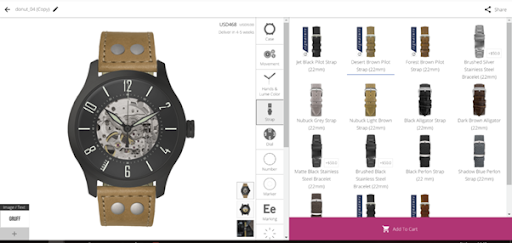
Wondering what all can a Product configurator do?
Ecommerce Product Configurator Based on Target Audience
The strategic goal of the configurator and target audience plays an important role in the conception of a product configurator. Let us look at this classification one by one:
- Marketing Product Configurators The main purpose of a marketing configurator is to get visibility on a complex product. It is useful for products that one cannot showcase in an attractive way using traditional methods.An ecommerce product configurator opens up a range of possibilities – visually – for consumers. However, it does not lead to a precise quote for any product. Marketing configurators help companies incite creativity within the audience. It gives a global view of a complex product in a simple, attractive, and visual manner.
Example: Tylko Parametric Shelves
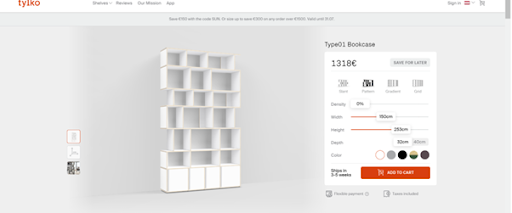
- Commercial Product Configurators Commercial product configurators are usually a part of ecommerce websites. It generates detailed quotes for sales representatives to follow up.It mostly involves B2C products and can largely affect sales. Recently there’s been an explosion of product configurators for commercial products. These products do not represent a complex category of products. It also helps optimize the supply chain beyond the sales process.
Example: Spreadshirt
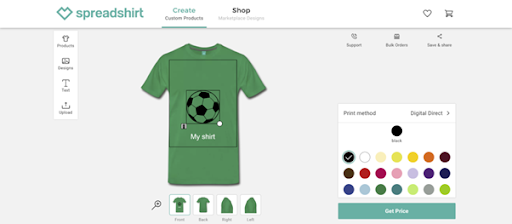
- Technical Product Configurators Technical product configurators usually focus on the details. It gives a realistic visualization as compared to the other two configurators. The main goal of technical configurators is to cover the product variations in a detailed manner.Sales representatives and B2B environments generally use technical configurators. Technical product configurators help the sales reps target clients by providing them with technical expertise.
Technical configurators also help to generate precise designs. It can also show the CAD files used for manufacturing. It can integrate flexibly with ERP systems. Nowadays, modular and parametric products can also integrate with technical configurators.
Example: Modular house with the Habitat21 configurator
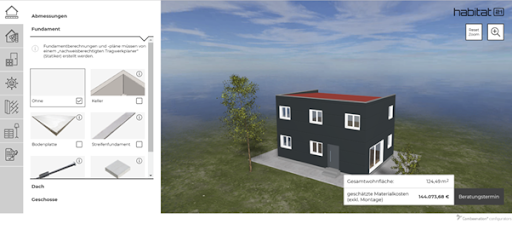
Next Generation Customization Software
Online product configurators are the answer to the mass customization challenges. The product customization industry has come to the forefront after facing and conquering certain sophisticated technological challenges. With these configurators, customers can quickly and easily customize products and even visualize them in real-time. They can instantly request a quote or order and pay online. Designs can easily convert to print-ready files.
It also creates buzz for the companies by creating excitement and engagement for users. In today’s ecommerce world, shoppers have many choices. Ecommerce product configurators are a great way to grab customers’ attention and increase conversion rates and grow sales.
Here are seven reasons why ecommerce businesses should adopt a product configurator:
- It increases engagement with your customers
- Research says customers are willing to pay more for customized products.
- Most customers expect a 3D configurator. 57% of consumers agree that they will stop buying from a brand if they have a better alternative.
- It’s the perfect solution for your designers as well as sales reps.
Top Features of Our Ecommerce Product Configurator
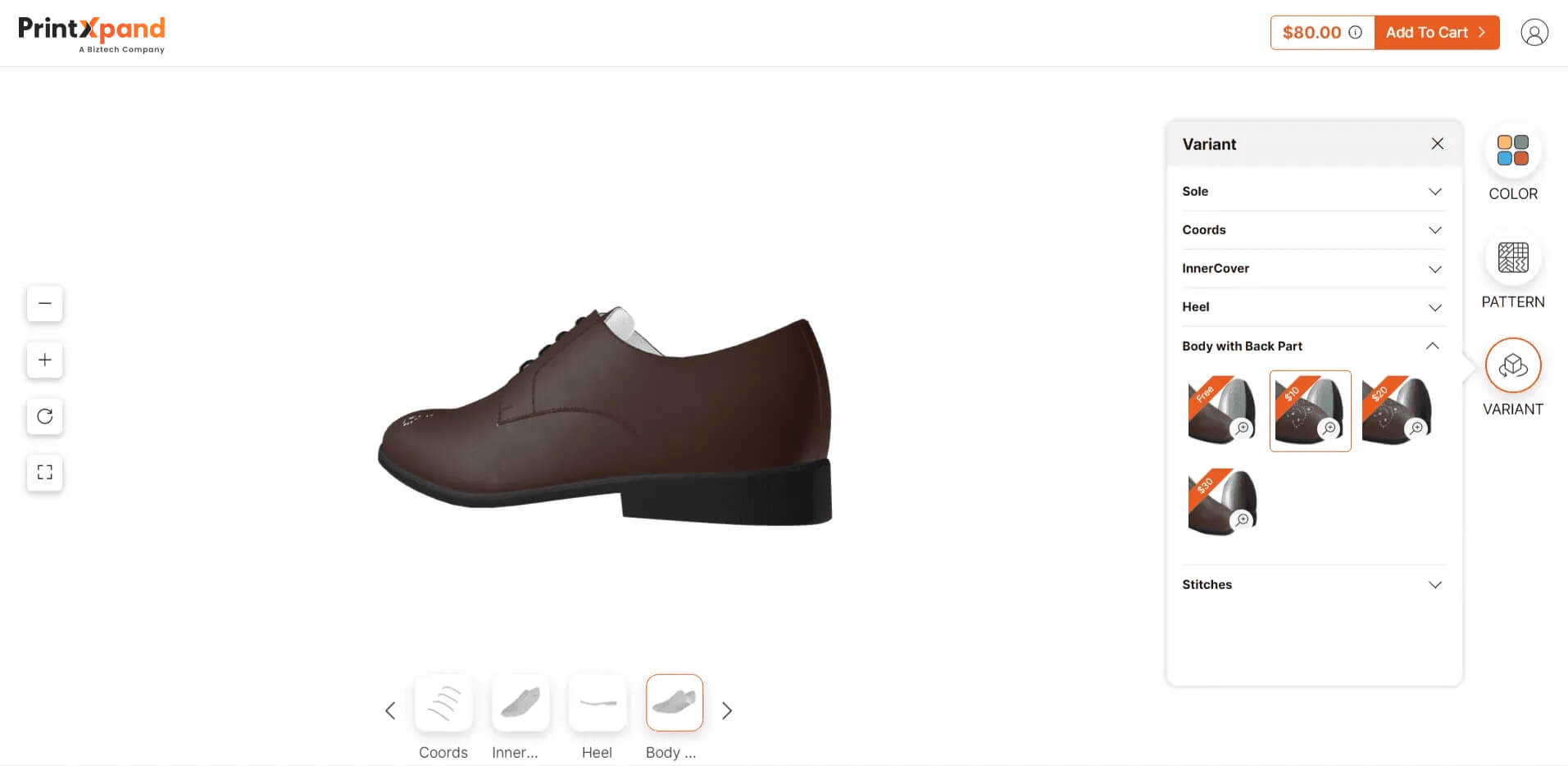
Make your products stand out:
With the 3D product configurator, your customers can interact with your products in a whole new way, allowing them to fully visualize and customize their purchases.
Easy to use:
The configurator is user-friendly, making it easy for even non-tech-savvy customers to use and customize your products.
Customizable options:
You can create a wide range of customizable options for your products, including colors, textures, materials, and more.
3D rendering:
The 3D product configurator uses high-quality 3D rendering technology to create realistic, detailed models of your products.
Mobile-friendly:
The configurator is optimized for mobile devices, so your customers can easily access and use it on their smartphones and tablets.
Real-time pricing:
The configurator provides real-time pricing information as customers make their customizations, helping them stay within their budget and preventing any surprises at checkout.
Seamless integration:
The 3D product configurator can be seamlessly integrated with your existing eCommerce platform, making it easy to set up and use.
Improved customer experience:
By offering a 3D product configurator, you can improve the overall customer experience, leading to increased customer satisfaction and loyalty.
Higher conversion rates:
The configurator can help increase conversion rates by allowing customers to fully visualize and customize their purchases, leading to a greater likelihood of them making a purchase.
Ready to see the magic?
Over to You
Nowadays, many companies claim to offer turn-key solutions that can tackle all the challenges by customization. However, it is essential to consider those claims with caution and rationalize your choices. If you want an ecommerce product configurator for your website, you need to go deep into the specifications to select the right tool.
Make sure that the solutions you choose can continuously evolve in this ever-evolving market. Evaluate the technology’s modularity and its ability to integrate an existing ecosystem without upsetting the ongoing one.
Regardless of the adopted solution, one key factor needs to remain at the forefront. Implementing a successful mass customization strategy involves creating a flexible workflow and functioning of a product that can be engaged at any point of its product life cycle.
We hope we were able to give you clarity about everything about an ecommerce product configurator. Now you know all the uses, types, and functions of a product configurator.
Over the last decade, the industry has made an enormous leap forward by developing better and faster technological solutions. As an emerging technology, product configurators have many challenges, but the industry is ready and equipped to overcome them. If you need a product configurator for your website, check out PrintXpand product configurator. It is the right amalgamation of flexibility and proper functionality. Our product comes with top functionalities and features, integrates with third-party tools easily, and provides flexible customization. See for yourself!
All product and company names are trademarks™, registered® or copyright© trademarks of their respective holders. Use of them does not imply any affiliation with or endorsement by them.


